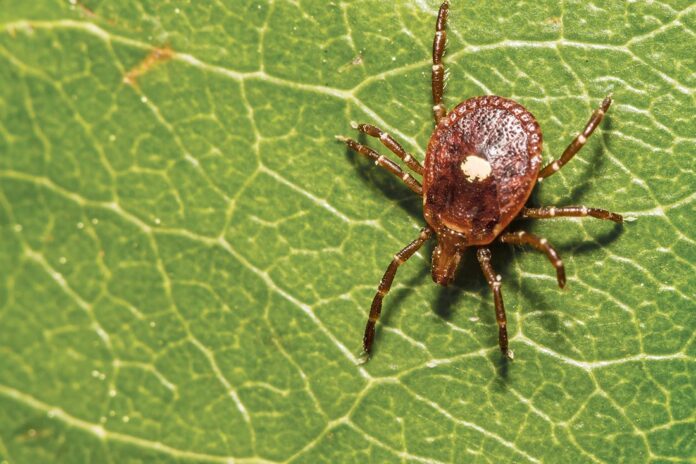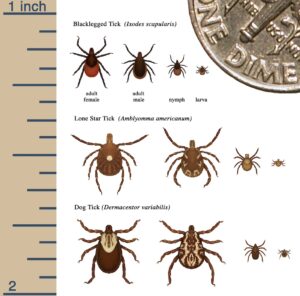
ROCKBRIDGE, Ohio — Andrea Jones first heard about a weird tick-borne condition that causes an allergy to red meat nearly 10 years ago. A few years later, a tick expert at her local Hocking Soil and Water Conservation district meeting described gastrointestinal symptoms and other issues like itching, rashes and swelling all caused by a tick bite and identified as alpha-gal syndrome. In the fall of 2023, when she awoke at 2 a.m. with the worst abdominal pain of her life, she was still surprised by her face.
“I went to the bathroom looking for something to relieve what I thought was heartburn, and looked in the mirror,” Jones remembered. “My face was swollen beyond recognition. My lips were puffed up three or four times. They were huge! I thought, ‘What in the world did I eat that caused this?’”
She had dinner at a friend’s that night and enjoyed a delicious flank steak. It was the only thing she could think of that was atypical. Jones found information online about alpha-gal syndrome. She realized the online list of symptoms matched her experience and called her doctor a few days later. After convincing her physician to run a diagnostic blood test, she got a referral to an allergist.
Unfortunately, the allergist didn’t know much about alpha-gal and advised Jones to simply avoid eating red meat. Jones soon learned meat was just the beginning.
Within a few weeks, dairy products caused severe gastrointestinal symptoms. Then, she had to change brands of lip moisturizer: The lanolin caused swelling, itching and worse skin irritation. Next, she had to change brands of toothpaste (because of glycerin, which may be from plants or mammals) and vitamins (which contained gelatin). Then, fumes from meat would make her sick, and she couldn’t be in the house if her partner was cooking.
The culprit
As Jones sought more information, she met Alpha-gal Alliance Action Fund founder Sharon Forsyth, who was diagnosed in 2019.
“I thought it was rare because I’d never heard of it,” Forsyth said. At that time, the CDC didn’t even have an information page (they do now). Forsyth, who lives in Washington, D.C., is a biologist who looks for rare butterflies. She turned to medical journals for more information.
Forsyth now runs a website and private Facebook support groups to help people with AGS. One of the groups she works with is Farmers and Ranchers with Alpha-gal Syndrome.”
“If you’re a hunter or a farmer, this isn’t just a food allergy,” she said. Farmers can react to their animals, breaking out in hives if amniotic fluid or blood touches their skin.
In the U.S., the tick that causes alpha-gal syndrome is the lone star tick. While they’ve been mostly concentrated in the southeastern part of the country, the ticks are moving north and west, and so is AGS.
The lone star tick is found from Florida to Maine and west to Oklahoma. In Ohio, they have been detected in every county, but are most prevalent in the wooded areas in the southeast and along the Ohio River. They are also found throughout Pennsylvania and in West Virginia.

According to the Pennsylvania Department of Environmental Protection, lone star ticks (Amblyomma americanum) have three developmental stages. Newly hatched larvae — about the size of the head of a pin — have six legs. They molt and become an eight-legged nymph, about the size of a poppy seed. After feeding, they will molt again to become an eight-legged adult. From larvae to nymph takes two to four weeks; from nymph to adult takes about two months. Females are the largest and are distinguished by a white dot on their back. Adult males are slightly smaller than adult females. Females lay eggs from seven to 16 days after feeding and can produce 3,000 to 8,000 eggs. Forsyth said that while some species of tick feed on small mammals and rodents, the keystone species for the lone star tick is deer.
According to allergist and alpha-gal researcher Dr. Scott Commins, from the University of North Carolina School of Medicine, alpha-gal syndrome is a unique allergy for several reasons. First, it’s an allergy to a carbohydrate (sugar) molecule, galactose-alpha-1,3-galactose. The name alpha-gal syndrome comes from the name of the molecule, which is found in all mammals except for humans and some other primates. It’s also found in the saliva of the lone star tick.
Researchers believe the tick injects the alpha-gal molecule into a person’s skin when it bites them. The person’s immune system recognizes a foreign substance and creates an allergic antibody (called the Immunoglobulin E, or IgE). This usually takes between four and six weeks following the tick bite, but may take up to a year. Then, when the person eats red meat, the antibody responds, which creates an allergic reaction. People may have comfortably consumed red meat their entire lives and suddenly have a reaction to it. The timing of the symptoms is another complication of alpha-gal syndrome.
“Reactions often occur during the night,” Forsyth said. “People eat meat at dinner.”
Multiple bites over time will make the reaction more intense. Other factors that can lead to worse reactions include alcohol, exercise and non-steroidal inflammatory medications such as ibuprofen (Advil, Motrin) and naproxen (Aleve). The food additive carrageenan, an emulsifier derived from seaweed, can also cause a reaction. Many drugs and medical products — like valves and sutures — come from mammals or contain mammalian ingredients and may cause allergic reactions.
Changes on the farm
Another complication? People who develop an allergic reaction may not remember getting bitten by a tick. That wasn’t the case for Clark Giles, a member of “Farmers and Ranchers with Alpha-gal.”
Giles lives about 40 miles east of Tulsa, Oklahoma. He raises sheep and loves to work in his garden. By day, he runs a water well service business; he spends most summer evenings outside until dark. He prefers to eat chicken and vegetables, but one night in the summer of 2022, he had a hamburger. At 12:30 a.m., he awoke covered in hives. He tried a cold shower and Benadryl, but his lips and face became numb. Realizing he was having an anaphylactic reaction, he rushed to the hospital.
“I puffed up like the Michelin Man,” Giles said. He knew he was bitten several times during the summer by ticks. A blood test confirmed the AGS diagnosis, and his doctor recommended eliminating dairy products as well as red meat. About six months after his first reaction, he became sensitive to cooking meat, caused by airborne alpha-gal particles. And his life has changed around the farm, as well.
“I got really sick after a ewe gave birth,” he said. Both blood and amniotic fluids can cause an allergic reaction if they get on his skin. Now, in order to work with his animals, he wears a respirator and nitrile gloves. Even driving around town can cause issues. If he gets stuck at the traffic light near the local Burger King, he will have a reaction if the wind is blowing towards his car. His ears will start ringing. If the exposure continues, he may have trouble carrying on a conversation. He calls it “brain fog.”
He’s been surprised by the number of products with mammalian ingredients that he must avoid. Like Jones, he changed brands of toothpaste and vitamins. He also avoids dryer sheets and Glade plug-in air fresheners. When he arrives at a client’s house, if they have pets, air fresheners or cooked bacon for breakfast, he wears a respirator.
Prevention is key
Free alpha-gal syndrome webinar for farmers and ranchers April 24
The AgriSafe network is holding a free webinar April 24 at noon titled “Tick Bites, Meat Allergy, and Caring for Livestock: What Farmers and Ranchers Need to Know” to discuss alpha-gal syndrome.
Presenters include Sharon Forsyth, executive director of the Alpha-gal Alliance, and Candice Matthis and Debbie Nichols, founders of Two Alpha Gals and the Alpha-gal Foundation.
To register or get more information, click here.
While there is no treatment yet for alpha-gal syndrome, some people have seen relief of severe symptoms after a few years, as long as they avoid additional tick bites. Forsyth’s website, alphagalinformation.org, provides tips for keeping ticks away, as does the CDC.
“Permethrin is a gift from God,” Forsyth said, referring to the insecticide used to pre-treat clothing. While it should never be applied directly to skin, and cat owners need to use caution, permethrin is the only repellent that kills ticks.
Other repellents that can be applied to a person’s skin, like those that contain DEET or Picaridin, can also be used, if you’re unable to pre-treat clothing.
Other typical tick prevention tips apply to the lone star tick as well, like avoiding wooded areas with dense, high grass and leaf litter. If you’re hiking in an area like that, stay on the middle of the trail.
Forsyth recommends wearing permethrin-treated shoes, socks, long pants and long-sleeved shirts and tucking shirts into pants and pant legs into long socks. Forsyth also wraps the top of her boots with double-sided carpet tape to trap ticks climbing up her legs and carries a lint roller. Before re-entering her car after a hike, she runs the lint roller over her clothes.
“Use (permethrin) tick repellent,” added Giles. “You don’t want this.”










Excellent article! Thank you!
Great article! Thank you for all the information!
Very interesting information. I live in the countrY. We have trees, deer, wild animals.i have alphagal and have had to make major changes. I have had excema when I changes to Tide. Which led to rash (looked like measles) ; hives, dry itchy skin with raised areas that looked like ringworm. Itching 24/7…..no end to the itching, rash, hives. I decided to get a second opinion at an urgent care facility. The pa wrote a prescription for me and?within three days the itching was much, much less. All of my issues we looking much better and drying up. I still use meds for the excema too. I have one more dose to take Sunday and am praying this stuff will be dormant. Then all I need to do is find out the allergies and avoid those things. FINS AND FEATHERS taste mighty good. Lots of water, veggies and fruits.